#Ming Dynasty (1368-1644 AD)
Text
[Hanfu · 漢服]Chinese Late Ming Dynasty(1368-1644 AD) Hanfu Photoshoot
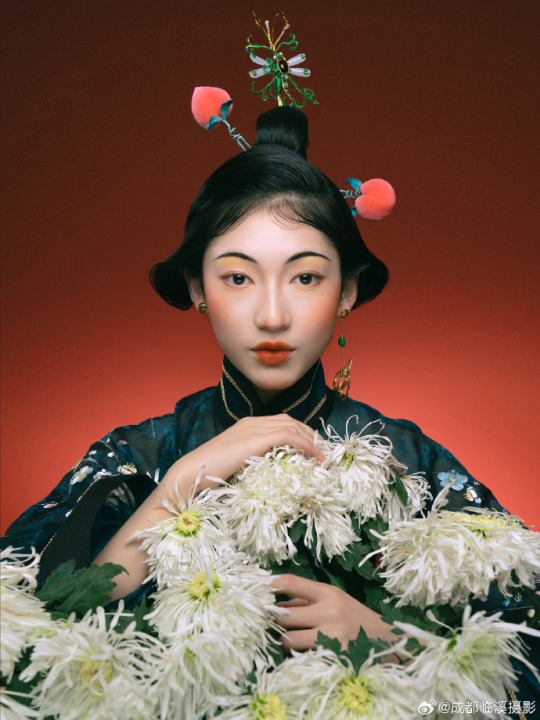
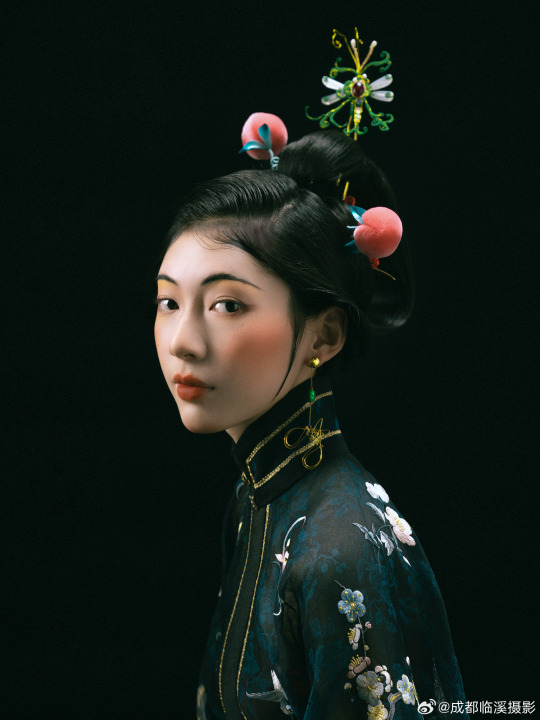
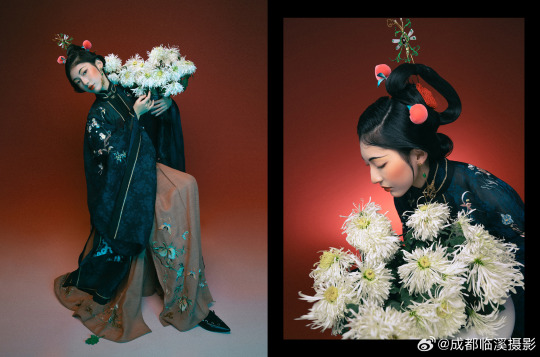
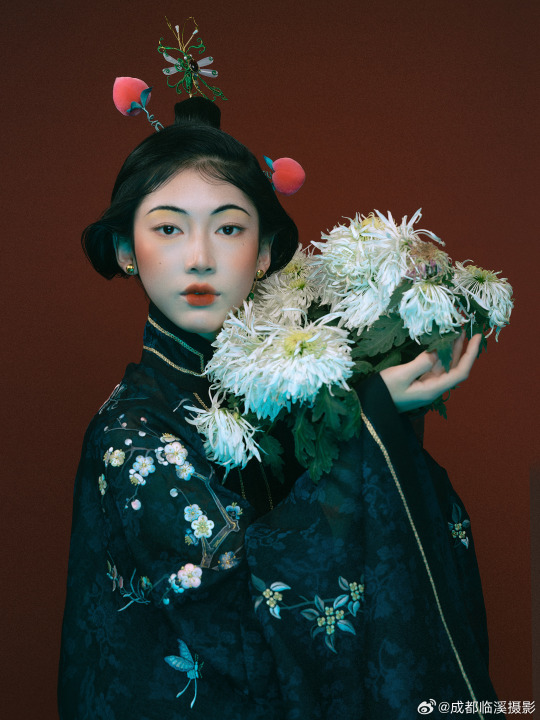
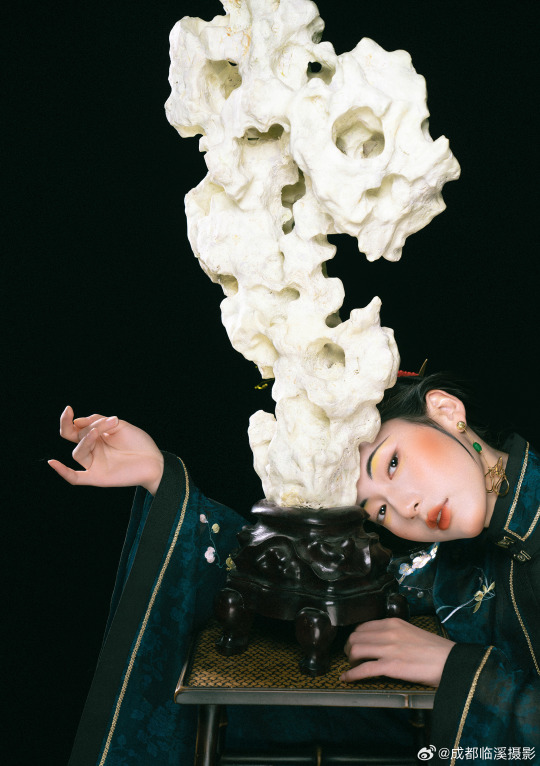
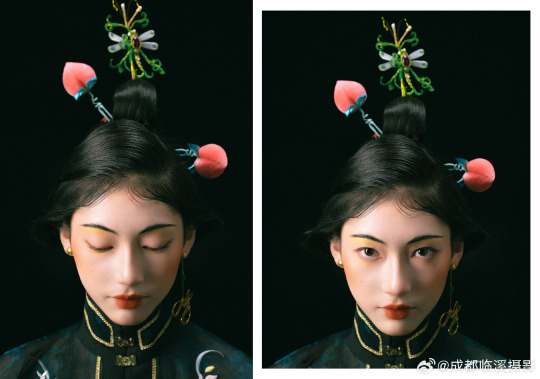
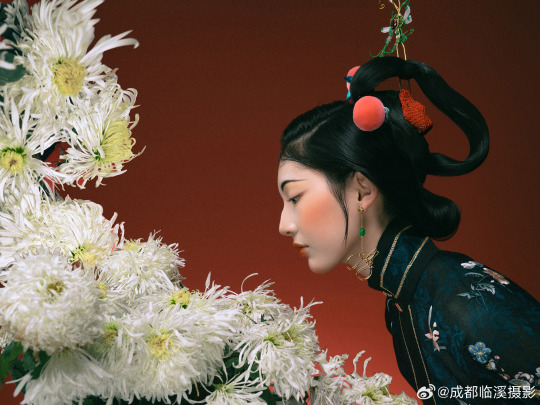

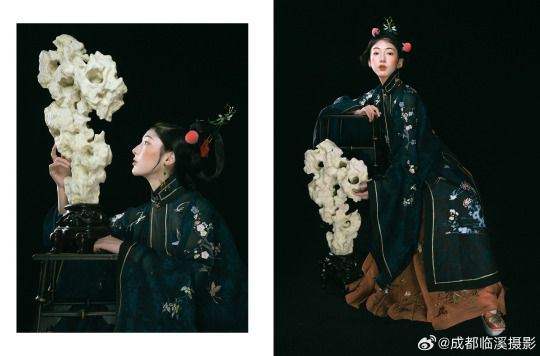

_______
📝 Plan:@成都临溪摄影
📸Instructor Photographer: 何力
💄Stylist: 百丽
🧚🏻 Model:宋长月
🔗Weibo:https://weibo.com/1648616372/Ny8c8eMo2
_______
#chinese hanfu#Ming Dynasty(1368-1644 AD)#hanfu#hanfu accessories#chinese traditional clothing#hanfu_challenge#china#chinese#hanfu photoshoot#hanfu fashion#chinese historical fashion#chinese style#漢服#汉服#中華風#late ming
195 notes
·
View notes
Text

Bejewelled gold butterflies, excavated at the Wang Bolu tomb, Xun County, Henan Province, Ming Dynasty, 1368-1644 AD
from The Henan Province
275 notes
·
View notes
Text
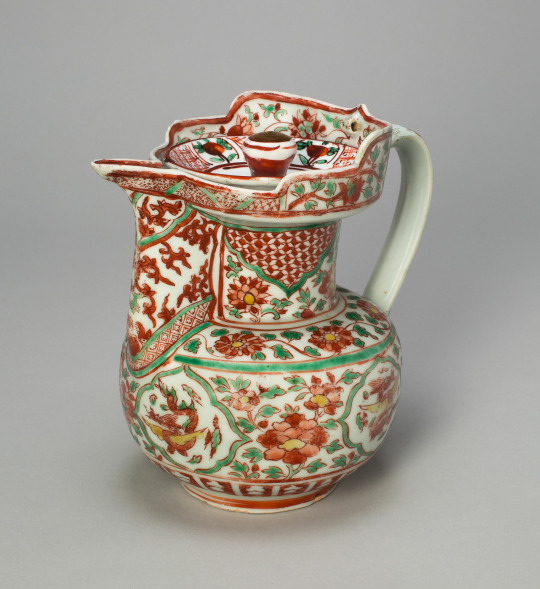
Covered Ewer with Dragons and Peonies
China, Ming dynasty (1368–1644), 16th century, overglaze painting added later; with Japanese lid bearing seal of Eiraku
21 notes
·
View notes
Text
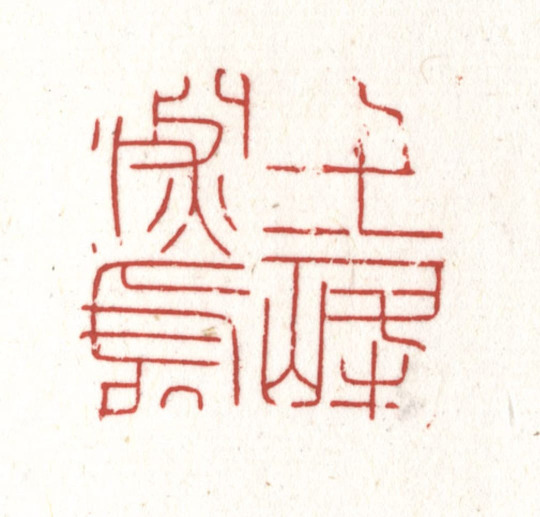


Ivory Seal with the Inscription “Qi Shi Er Feng Shen Chu” (“depths of the seventy-two peaks”) by Wen Peng, Ming dynasty (AD 1368-1644).
In the mid and late Ming dynasty, seal carving began to prevail among literati. Wen Peng mainly carved seals with Qingtian Stone, and was hailed as the founder of the seal cutting genre. He also carved some stone and ivory seals, but few have survived. This ‘Deep in the 72 Peaks’ ivory seal was said to be unearthed during the period of Anti-Japanese War, with the cursive script of ‘Wen Peng’ seen on the left side.
Courtesy Alain Troung
23 notes
·
View notes
Note
How long would it have taken to carve 100 chapter woodblocks for the 1592 Journey to the West? Wu Cheng’en died in 1580-1582 so when would he have submitted his work?
Wu Cheng'en's authorship is not completely settled among the academic community. But even if he contributed to the standard 1592 edition of the JTTW, he only added his own flourishes to an already extant body of episodes. For example, during the Ming (1368-1644), there were no less than three versions of the novel in circulation. These include:
The 1592 edition, Newly Printed, Illustrated, Deluxe and Large Character, Journey to the West (Xinke chuxiang guanban dazi Xiyou ji, 新刻出像官板大字西遊記).
The "Zhu edition," Newly printed, Completely Illustrated, Chronicle of Deliverances in Sanzang of the Tang’s Journey to the West (Xinqie quanxiang Tang Sanzang Xiyou shi ni (e) zhuan, 新鍥全像唐三藏西遊释尼(厄)傳) by Zhu Dingchen (朱鼎臣) of Yangcheng (羊城, i.e. Guangzhou).
The “Yang edition,” Newly Printed, Complete Biography of Sanzang’s Career (Xinqie Sanzang chushen quanzhuan, 新鍥三藏出身全傳) by Yang Zhihe (陽至和) of Qiyun (齊雲).
Koss (1981) shows that the 1592 edition is an expansion of Zhu, and Yang is a later abridgement of the former. Zhu being the oldest, with portions likely predating 1450, is based on its earlier style phrasing and chapter structure; the use of vernacular language with simplistic two-person dialogue and fewer and less literary poems, suggesting a reliance on oral literature; and Zhu illustrations serving as the basis for many pictures from the 1592 edition.
As you know, Wu died 10 years before the 1592 edition was published, so it was later published anonymously. But since portions of the 1592 JTTW are almost exactly the same as the Zhu version, it may not have taken long to finish the chapter woodblocks.
You can read more about this here:
Edit:
Here is an example of how close certain sections of the Zhu version are to the 1592 version. The following quote describes the first time that Monkey meets the Patriarch Subodhi. It then continues with a poem describing the awe-inspiring presence of the holy master. The red indicates differences in the Zhu edition:
With solemnity the Monkey King set his clothes in order and followed the boy into the depths of the cave. They passed rows and rows of lofty towers and huge alcoves, of pearly chambers and carved arches. After walking through innumerable quiet chambers and empty studios, they finally reached the base of the green jade platform. Patriarch Subodhi was seen seated solemnly on the platform, with thirty lesser immortals standing below in rows. He [It] was truly [a realm of immortals. Let’s listen to the explanation in the next chapter]:
A Golden Immortal of Great Awareness and of great ken and purest mien,
Master Bodhi, whose wondrous appearance like the West
Had no end or birth by work of the Double Three.
His whole spirit and breath were with mercy filled.
Empty, spontaneous, it could change at will,
His Buddha-nature able to do all things.
The same age as Heaven had his majestic frame.
Fully tried and enlightened was this grand priest (Wu & Yu, 2012, vol. 1, p. 114).
這猴王整衣端,隨童子徑入洞天深處觀看:��層層深閣瓊樓,一進進珠宮貝闕,說不盡那靜室幽居,直至瑤台之下。見那菩提祖師端坐在台上,兩邊有三十個小仙侍立台下。果然是座仙境。且聽下回分解。
大覺金仙沒垢姿,西方妙相祖菩提,不生不滅三三行,全氣全神萬萬慈。空寂自然隨變化,真如本性任為之, 與天同壽莊嚴體,歷劫明心大法 (原作“怯”) 師。
The Zhu version is comprised of ten scrolls (juan, 卷) with three to ten subsections each. These subsections differ from the chapter layout of the 1592 edition. For example, subsections one to three and four to five respectively correspond to chapters one and two of the 1592 edition (Koss, 1981, pp. 14-15). It’s interesting to note that the above quote describing Monkey and Subodhi's meeting caps the first subsection of scroll one. This is why it ends with: “Let’s listen to the explanation in the next chapter” (qieting xiahua fenjie, 且聽下回分解).
Source:
Koss, N. (1981). The Xiyou ji in Its Formative Stages: The Late Ming Editions (Vols. 1-2). (Doctoral dissertation). Available from ProQuest Dissertations and Theses database. (UMI No. 8112445)
18 notes
·
View notes
Text
Okay, you know what? I saw @lem0nn-juice’s latest post about Wukong being unable to read being a joke and they’re right. Wukong clearly knows how to read, considering he’s sent letters to Qi Xiaotian.
But do you know who actually probably has trouble reading?
DBK.
After doing some research, here’s what I know.
We know DBK was sealed away for five hundred years. We don’t know when because we don’t know the current year LMK is set in. It could be in the distant future or in a world where technological advancements were made much earlier thanks to magic. That flashback in the beginning seems to keep the clothing pretty simple and it also seemed to be in a farming village where clothing didn’t really matter and was kept simple for ease. I personally do not have enough fashion history knowledge to pick out a particular era from what we see. Here’s what I do know thanks to research.
Mandarin, the most commonly known member of the Chinese language family, emerged during the Ming dynasty. This era is from 1368-1644 and is also when Journey to the West is published. But the actual journey that the novel is based on started in 629 AD to 646 AD, placing it in the Tang dynasty which lasted from 618-907 AD, a full 289 years and seemed to use Middle Chinese. This seems to be the best starting point we can guess of when DBK was sealed away.
The Tang dynasty was in the sixth century. The Ming dynasty was in the 16th century. That’s a full millennium between them. If we were to say that DBK was sealed away during the Ming, Mandarin was still just emerging. And even then, the language went through shifts and changes over the centuries.
So, yeah. DBK probably picked up on speaking the current version Mandarin fairly quick. But reading and writing? With a new writing system he had no idea how to use or had changed from what he did know? He’s probably having to relearn that.
(If I got anything wrong or if there’s a bit of info I missed please tell me.)
65 notes
·
View notes
Text

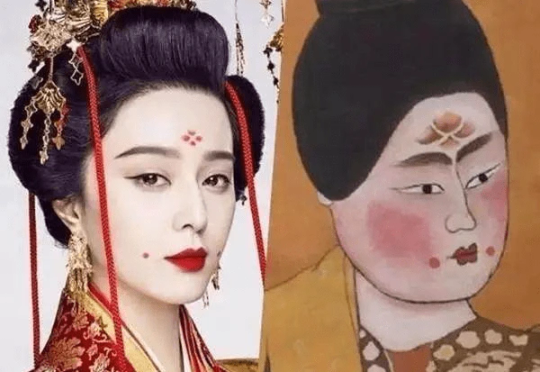

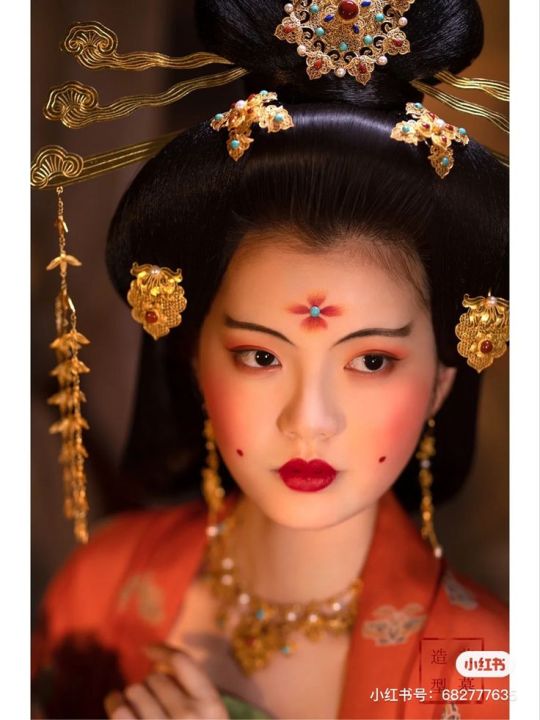


Traditional Chinese makeup is rich in history and symbolism. Back in the day, dating all the way back to 1600 BCE, the Chinese women often focused on lots of colour and designs on different spots on the face, symbolizing good fortune, happiness, desire, and others. wishes, symbols. Eyebrows have always been a big part of their makeup history as well, styling them in every way imaginable. Traditional Chinese makeup is is a beautiful blend of artistry, cultural significance, and timeless beauty, there has been many changes throughout their history and each dynasty has something special about it. Starting with the Shang dynasty that lasted from 1600 - 1046 BCE. Not a lot is known from this time, but it is known the people then loved using bold colours and intricate designs, they used colours like white, red, green and black to their lips, eyelids and cheeks. Something also interesting is they used extracted juice from leaves of red and blue flowers as rouge. Next is the Zhou dynasty, 1046 - 256 BCE. This was the dynasty that makeup was really shown to us, the one that we know more of as being the 'first signs of makeup'. This was the dynasty for facial cream, lip gloss, fragrance and all the really light makeup. The people of this time started using grease from animal fat or plant seed oil to make their cosmetic products. The Han dynasty, 206 BCE - 220 CE, this is the dynasty where the people started wearing more makeup again. But, not in the safest way... Due to social status, the upper class women used ingredients like ground up tin and lead to create their perfect base, whereas the poorer folk used materials like ground up rice grains for their makeup, less whitening, but still effective. The product, Dai was also introduced during this time which was a simple greenish, black paste made up of burnt willow sticks and water for the women to draw their eyebrows on after they had shaved theirs off. This was done to keep up with the trends and have whatever eyebrow shape was popular next. Tang dynasty, from 618 - 907 CE, during this dynasty is when the women of ancient China really started to give makeup their all. This era used more colour, designs and significance than any other, they brought back Haudians, small symbols that could go on in many colours, painted on a woman's face to represent court ladies and other high ranking women. Mianyes which are like haudians, but placed at the corners of the mouth instead of the forehead which is where haudians are usually placed. And, lastly, xiehong, crescent shaped haudians painted at the temples. For the Song dynasty this is when women started to revert back to the natural makeup look, only using white and red in their routine, often using white to highlight points of their face like their forehead, chin, and nose. Something that happened during this time too was Dai was replaced by ink to draw on ones eyebrows. The Ming dynasty, reigning from 1368 - 1644, they were very similar to the Song dynasty they used their makeup to more compliment their natural beauty instead of wearing really heavy makeup. They also started making themselves less white and more healthy by adding less product and using rouge carefully, placing lightly and only on the cheeks. Last but certainly not least, the Qing dynasty, 1644 - 1912, this is the dynasty we know the most about as its the most recent and we had cameras for the ending of this dynasty so we have photographic proof of their makeup was and what the styles were. This was another dynasty for the simple, clean makeup after 2000 years of heavy blush. The women of this time focused on highlighting natural beauty and keeping themselves clean looking.
Makeup Trends Throughout Ancient Chinese History – Euphoric Sun
Collection of Ancient Chinese Makeup Style (Each Dynasty) - Newhanfu
A Brief History Of Beauty - How Beauty Was Seen In Ancient China — THE FEM WORD
2 notes
·
View notes
Text
Chang'e Flying to the Moon (嫦娥奔月) is the most widely told Mid-Autumn Festival legend. It is said that in ancient times, ten suns existed in the sky and the extreme heat made people’s lives very difficult. It was the hero Hou Yi, who, using his great strength, shot down nine of the ten suns. Later, Hou Yi married a beautiful and kind-hearted woman named Chang'e and lived a happy life.

One day, the Queen of Heaven presented Hou Yi an elixir which, if took, would help him to ascend immediately to heaven and become a god. Hou Yi took it home and asked Chang E (嫦娥) to keep it. Unfortunately, a villain named Pengmeng got to know this, broke into their home and demanded Chang'e hand over the elixir while Hou Yi was out hunting. In a moment of desperation, Chang'e swallowed the elixir. Reluctant to leave his husband, Chang'e tried her best to fly to the moon, the nearest place to the earth in heaven. Houyi missed Chang'e a lot, so on the day of the full moon he placed on tables foods that Chang'e liked. This custom was later followed by folk people praying to the Goddess Chang'e for good luck and gradually formed the Mid-Autumn Festival (中秋节).
youtube
Zhu Yuanzhang and Mooncake Uprising - This is a Mid-Autumn Festival legend really happened. In late Yuan Dynasty (1271 - 1368 AD), people in many parts of the country could not bear the cruel rule of the government and rose in revolt. Zhu Yuanzhang, founder of Ming Dynasty (1368 - 1644 AD), united the different resistance forces and wanted to organize an uprising. However, due to the strict search by government, it was very difficult to pass messages. The counselor Liu Bowen later though out the great idea of hiding notes with “uprise on the night of Mid-Autumn Day” in moon cakes and had them sent to different resistance forces. The uprising turned to be very successful and Zhu was so happy that he awarded his subjects with moon cakes on the following Mid-Autumn Festival. Since then, eating moon cakes has been a custom on Mid-Autumn Festival.

Info and image credits.
#Mid-Autumn Festival#中秋节#农历八月十五#Celebration#Chinese Culture#Festival#Mooncake#月饼#Chang'e#嫦娥#奔月#Rabbit#Legend#Zhu Yuanzhang#朱元璋#Mooncake Uprising#Video#Dessert#Snack#Food#Buffetlicious
13 notes
·
View notes
Text

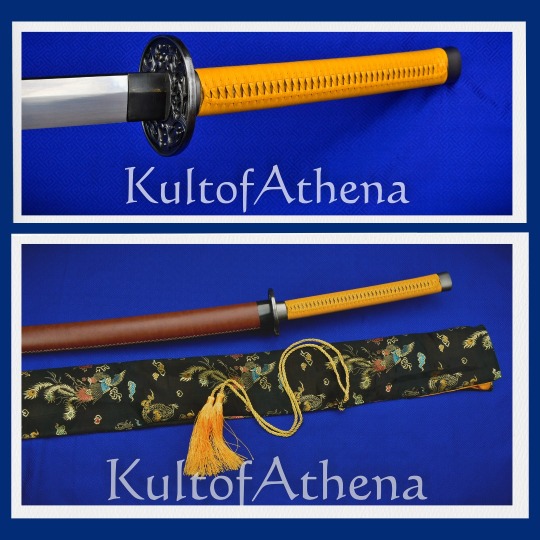


New in stock: LK Chen – Ming Crossbowman’s Dao.
The versatility of Ming Dynasty (1368 – 1644 AD) soldiery is evident in this specialized, two-handed Dao. It is an impressive sword with a long and sweeping cutting blade balanced by a long grip. In capable hands this sword will strike with great force and will cut cleanly and decisively; Chinese Ming soldiers who were armed with these swords as a sidearm could switch from being a ranged element of the army to a cadre of shock infantry with these hard-hitting swords in hand. The length of this Dao was carefully proportioned so that it would not interfere with the crossbow, both of which would be strapped and attached to the waist of the Ming Crossbowman.
The influence Katana of Japan is immediately evident in the wedge-shaped cross section of the blade which features a thick and rigid blade spine with a long, angled plane which terminates in an acute edge – an ideal shape for biting into and widely separating a target as the blade passes through it. The elaborately styled and well-cast guard of antiqued stainless steel is matched with a grip collar and pommel on the hilt. The guard is a 1:1 recreation of a Ming Dynasty original which lends the hilt an elevated level of authenticity. The grip is fashioned from hardwood which is overlaid in bold orange cord. The long tang of the blade extends through the whole length of the grip and the tang is anchored into the hilt with a peen over the pommel and a pair of bamboo pins that firmly affix the tang to the wooden grip.
The sword is matched with a durably crafted scabbard of wood which is tightly overlaid in finely-stitched brown leather which is completed with a locket and chape of antiqued and blackened brass fittings. Included is a sword bag of silk for storage or transport.
#Kult of Athena#KultOfAthena#LK Chen#Ming Crossbowman's Dao#Crossbowman's Dao#Dao#sword#swords#Daos#weapon#weapons#blade#blades#China#Asia#Chinese Sword#Chinese Swords#Chinese Weapon#Chinese Weapons#Asian Sword#Asian Swords#Asian Weapon#Asian Weapons#Ming Dynasty
4 notes
·
View notes
Text
Ming dynasty (1368–1644)
Ewer with Paired Dragons amid Cloud
Scrolls
China
Ming dynasty (1368-1644), zhengde
reign mark and period (1506-21)
Porcelain painted in overglaze green and
yellow enamels
Gift of Russell Tyson, 1954-473
Garlic-Headed Bottle with Mandarin
Ducks and Birds in a Lotus Pond
China
Ming dynasty (1573-1620)
Porcelain painted in underglaze blue and
overglaze polychrome enamels
Gift of Russell Tyson, 1964.692
The introduction of brightly colored enamels brought new vibrancy to porcelain design and new
challenges to Chinese Potters. Enamel colorants derive from metalic oxides and can be applied
only to fired porcelains- usually, but not always, after glazing. As enamel fuses to the porcelain
body at a lower, temperature, it requires a separate firing in a separate kiln, Successive firing at
precisely different temperatures added additional layers of technical complexity to a demanding
process that already requires the collaboration of countless specialists.
These vessels reflecting the range of designs, colors, techniques and levels of quality in enamel
decoration found in imperial porcelains from the 16th and early 17th centuries. Unlike other
vessels in this case, the yellow-and-Green ewer and bowl at the far right were enamled directly
on the underglazed clay. More complex palettes combine underglaze blue and underglaze
polychrome enamels. These traditionally termed wucal- literally, “ five colors” -regardless of the
number of colors applied in addition to the all- pervasive dragon, seen here are bold aquatic
scenes and even caricature-like figures of Taoist immortals. Some porcelains are meticulously
decorated, others more casually so.
Dish with floral and fruit
Sprays (“Gardenia Dish”)
Ming dynasty (1368-1644), Hongzhi reign
Mark and period (1488-1505)
China
Porcelain painted in underglaze blue and
Overglaze enamel
Charles H. and Mary F.S.Worcester Collection Fund, 2016.97
Recent Acquisition
Perhaps commissioned for imperial dining, this dish abound in auspicious botanical imaginary.
The motifs were first painted in underglaze blue and careful silhouetted with brilliant yellow
enamel before retiring.
The flower at the center, a gardenia, is admired for its beauty and fragrance as well as valued to
for its use in the production of pigment and traditional herbal medicine. Each of the four plants
encircling the gardenia blossom has symbolic importance: the pomegranates allude to fertility
persimmons to wealth; grapes, vines and seeds to progeny; and lotus to purity. Rose blossoms
and budding stems, signifying longevity, encircling the exterior.
This dish was formerly in the collection of Edward H. Bennet (1874-1954), a prominent Chicago
architect best known as the designer of Buckingham Fountain.
Bowl with Gold of Longevity (Shoulao)
and Eight Taoist Immortals
China
Ming dynasty (1388-1644), Wanli reign
mark and period (1573-1620)
Porcelain painted in underglaze blue and
overglaze polychrome enamels
Gift of Dorothy Braude Edinburg to the Harry B. and Bessie K. Braude Memorial Collection,
2002.628
The unconventional figures encircling this bowl are Taoist immortals: historical persons and
legendary characters to collectively symbolize good fortune and individually denote different
conditions of the life (wealth, poverty, youth, old age, etc.) the central figure depicts the God of
Longevity (Shaolao), identifiedmby his scepter and domed cranium.
Covered Hexagonal Lobed Jar with Dragon
Chasing a Flaming Pearl
Ming dynasty (1368-1644), Wanli reign mark
and period (1573-1620)
China
Porcelain painted in underglaze blue and
overglaze polychrome enamels
Gift of Russell Tyson, 1951.300
Vase in the Form of a Bronze Wine Vessel,
with Dragons, Waves and Trigrams
China
Ming dynasty (1368-1644)
Mark and period (1573-1620)
Porcelain painted in overglaze enamel
Bequest of Russell Tyson, 1964.690
Cylindrical Bowl with Dragons Chasing
a Flaming Pearl
China
Ming dynasty (1368-1644), Zhengde
Porcelain with overglaze yellow and green
enamels, ground with incised decoration
Gift of Russell Tyson, 1951.301
0 notes
Link
Check out this listing I just added to my Poshmark closet: Reed & Barton Ming Dragon Medallion Mirror Sterling .925 Pouch Paperwork 1970's.
0 notes
Photo

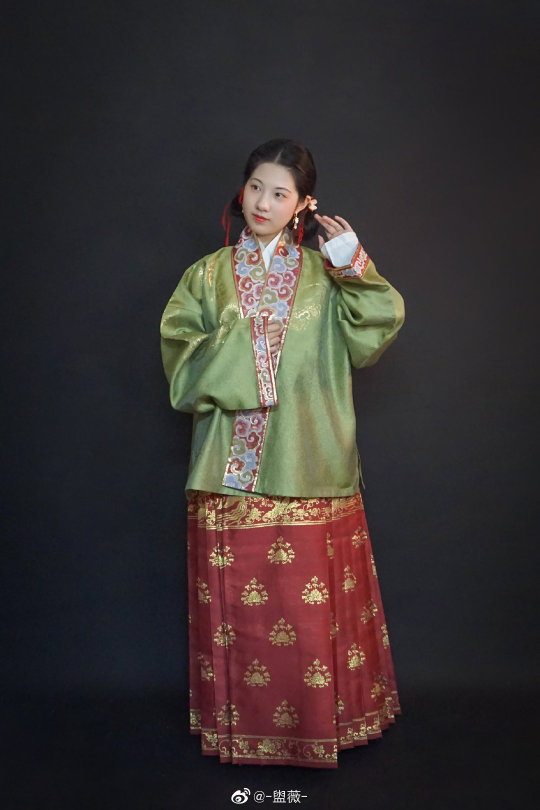





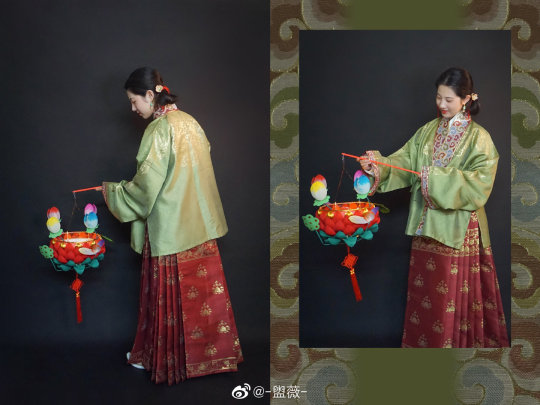



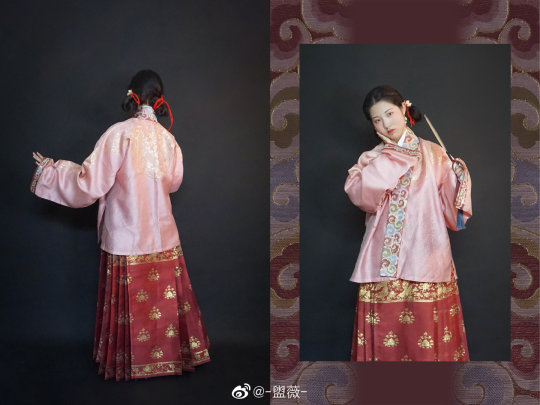
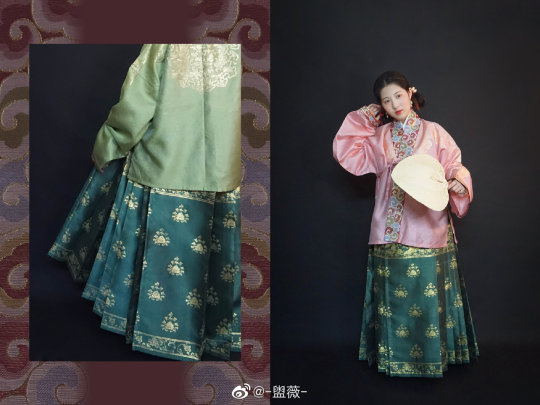
【Historical Reference Artifacts】
China Ming Dynasty Painting《夏景货郎图/Knick-knack Peddlers in Summer》,The Palace Museum,Beijing,China collection
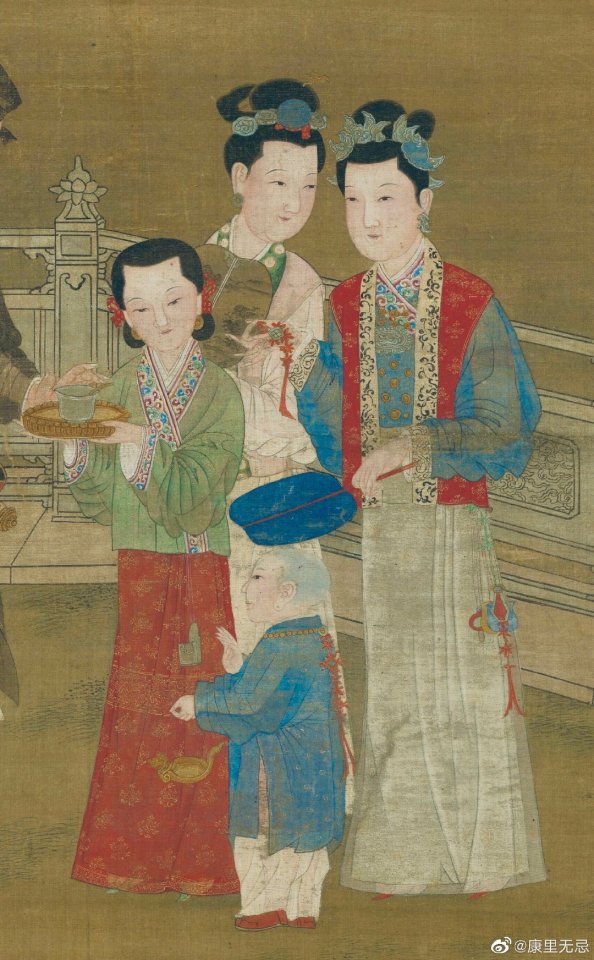


[Hanfu · 漢服]Chinese Ming Dynasty (1368-1644 AD) Traditional Clothing Hanfu Based On Ming Dynasty Painting《夏景货郎图》
________________
💃🏻Recreation Work:@-盥薇-
👗 Hanfu:@香染衣罗传统服饰
🔗Weibo:https://weibo.com/3942003133/Kj5P8okSU
________________
#Chinese Hanfu#Ming Dynasty (1368-1644 AD)#夏景货郎图/Knick-knack Peddlers in Summer#chinese traditional clothing#chinese#chinese historical fashion#Chinese Culture#historical fashion#hanfu#chinese history#hanfu accessories#hanfu artifacts#漢服#汉服#recreation
651 notes
·
View notes
Text

bailuweixi2518
Taierzhuang: Ancient Chinese Town Rebuilt Over Its Ruins
Built during the rules of the Qin (221-207 BC) and the Han Dynasties (206 BC-220 AD), the ancient city of Taierzhuang is a World Cultural Heritage site at the center of the Beijing–Hangzhou Grand Canal. Due to its social and economic status, Emperor Wanli of the Ming Dynasty (1368-1644) declared the site “the First Town on the Earth.”

cgtnarabic

snapshot_____story

cgtnenespanol
#taierzghuang#china#ancient#architecture#bailuweixi2518#photographer#world cultural heritage site#beijing-hangzhou grand canal#the first town on the earth#cgtnespanol#cgtnarabic#snapshot_____story
1 note
·
View note
Text
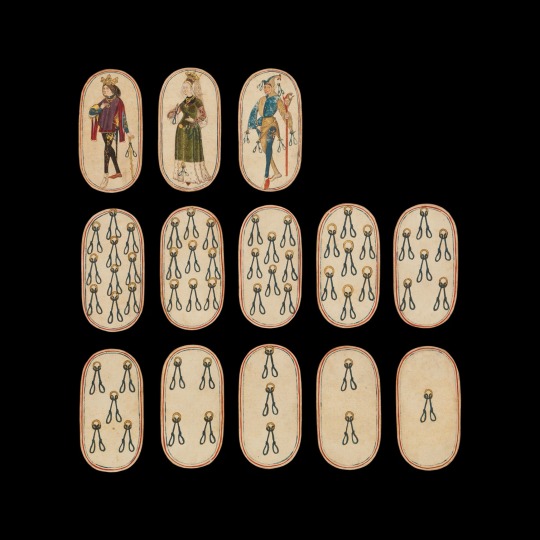
It is not known how these cards were played, but almost all card games from 15th century Europe involved some form of gambling. Since at least the 7th century, people throughout the world have used used cards for games or as collector's items. Photograph By The Metropolitan Museum of Art, New York
The Original Pokémon? A Visual (Ancient) History of Trading Cards
Our love of playing cards dates farther back than you think—perhaps as far back as the T’ang Dynasty. Here’s a look at their colorful past.
— By Elaina Zachos | November 3, 2023
In a world filled with endless entertainment, some of the simplest and most enduring sources of amusement can be found in a deck of playing cards.
For centuries, these unassuming game pieces have held a special place in the hearts and hands of people across the globe. From the hand-painted cards of T’ang Dynasty China to paper-and-plastic Pokémon trading cards, the history of playing cards spans cultures, epochs, and continents.
When The Walt Disney Company celebrated its 100th birthday last month, everyone got to take part in this century’s-long tradition with TikTok’s new digital playing card game. As a member of the mouse-eared family, Nat Geo saw over four million new followers scurry to our TikTok account, mostly to trade these digital cards.
This got us thinking—what’s the history of playing cards anyway?
China A.D. 600-1600s
It’s unclear when and where playing cards were invented, but they were popularized in China more than a thousand years ago. References to “domino cards” existed as early as the T’ang Dynasty, which lasted from 618-907 AD. Some historians, however, say playing cards took off during the 10th century. Either way, these cards were originally hand-painted on paper or parchment.
Fast-forward a few hundred years to the Ming Dynasty—which lasted from 1368-1644 AD—and you’ll find playing cards gaining steam. At this point, some cards had images of characters from popular novels. Others were “money cards” with suits inspired by old Chinese currency.
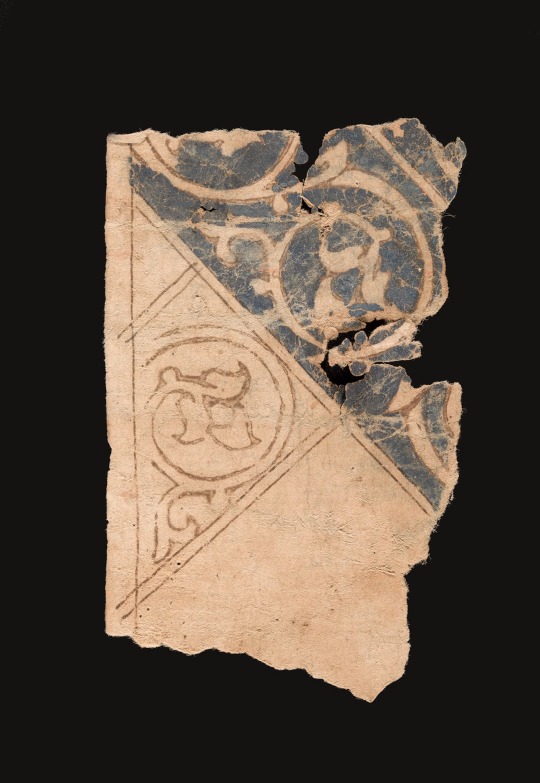

Left: These playing card fragments date to 13th and 16th century Egypt and are remarkably similar to those used today, with fifty-two cards divided into four suits: cups, coins, swords, and polo sticks.
Right: Unlike their Western counterparts—the king, queen, and jack—Mamluk court cards do not feature figural imagery but are identified through a combination of symbols and label-like inscriptions. Photographs By Museum Associates/LACMA
Egypt 1300s-1500s
From China, playing cards were likely carried to the Middle East via the Silk Road.
One deck dates back to the Mamluk Sultanate of Egypt, which ended in 1517. These hand-painted cards were adorned with intricate calligraphic rhymes and likely belonged to a wealthy owner. They carried suits of coins, cups, swords, and polo sticks. Each suit would have had 13 cards, including three all-male court cards: the King, the Lieutenant, and the Second Lieutenant.

These French playing cards were made in the 18th century. The suit, hearts, are hidden in the cartoonish faces depicted on the card. Photograph By The Trustees of The British Museum
Italy, Spain, and France 1400s-1700s
There’s wide speculation on how playing cards eventually made it to Europe, playing card historian Peter Endebrock told Atlas Obscura in 2020. But most historians agree they suddenly showed up by the end of the 1300s, possibly introduced by Crusade-era soldiers.
Europeans loved these cards. Hand-painted and elaborately designed, playing cards were originally a luxury good popular among the wealthy. However, printing presses and stencils eventually helped to simplify the patterns on the cards and made them more accessible to a wider audience. By the 15th century, playing cards could be found throughout the continent’s inland trade routes.
In the Middle Ages, playing cards began to take on divination capabilities, which marked a significant shift in the use of the cards. For example, the Tarot deck, originally for competitive card games, later morphed into a tool for fortune-telling.
Today, the 52-card French deck is the most famous playing card deck. Its four suits (hearts, diamonds, clubs, and spades) and two colors (red and black) are well-known to players around the world. The deck’s popularity is partially due to its simple design and because it was a favorite among the most prominent imperialist powers: France, the United Kingdom, and the United States.
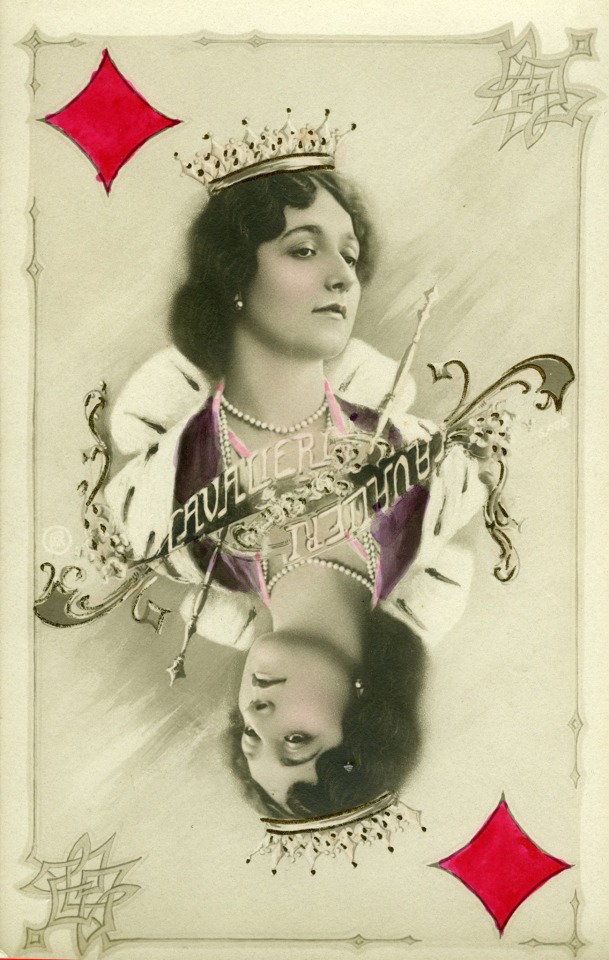
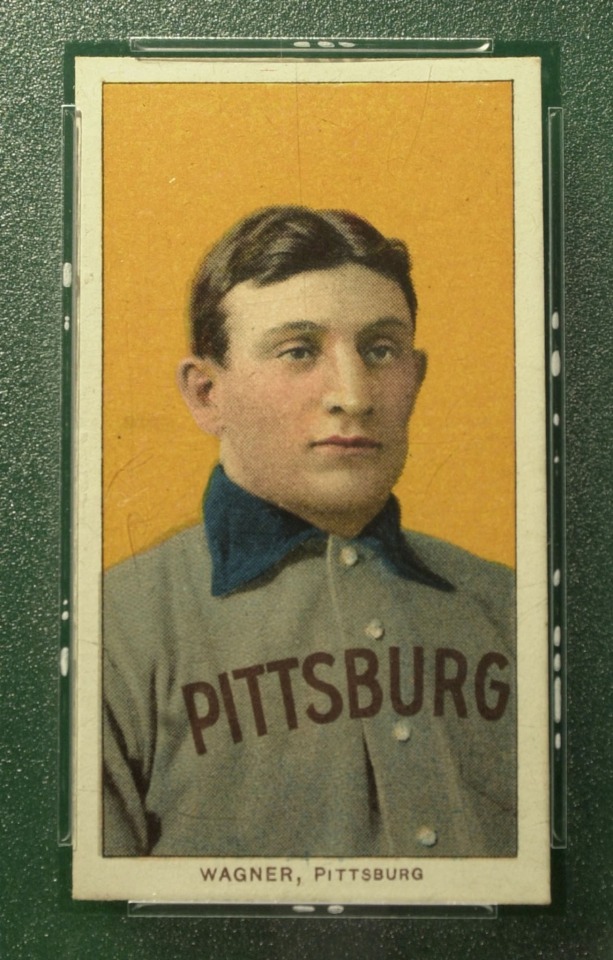
Left: Early collectible cards didn't just feature athletes—some depicted celebrities. The women show here was French dancer Cleo de Merode, who lived from 1875 to 1966. Photograph By Transcendental Graphic/Contributor
Right: Honus Wagner was an American baseball player during the turn of the century. The baseball card seen here sold for a record $7.25 million in 2022. Photograph By Chris Hondros, Newsmakers/Getty Images
U.S. Athletes and Celebrities 1800s-1900s
Heavily taxed playing cards circulated in the American Colonies before the Revolutionary War. After, U.S. printers began making their own copies. Americans eventually introduced Joker cards to French decks around 1860.
Trading cards, similar to TikTok’s Disney100 collectibles, originated as “trade cards” around the same time as jokers. First sold as advertising cards, they were packaged up with cigarettes to keep the packaging stiff.
Multi-color printing around the turn of the century made trade cards even more popular. Although the cards were not related to specific products, companies began including them in packaging as a sort of prize for consumers. By the time baseball became a professional sport, sports trade cards were printed and sold in candy and tobacco products.
Members of the public began collecting these cards and trading them with each other. In the 1930s, companies began printing athletes’ biographies on baseball cards and selling them in packs of bubble gum. By 1949, Topps Chewing Gum was including cards of athletes, cinema stars, and big game hunters in their products. People started viewing sports cards as valuable collectibles in the 1980s, despite their low monetary worth years earlier.
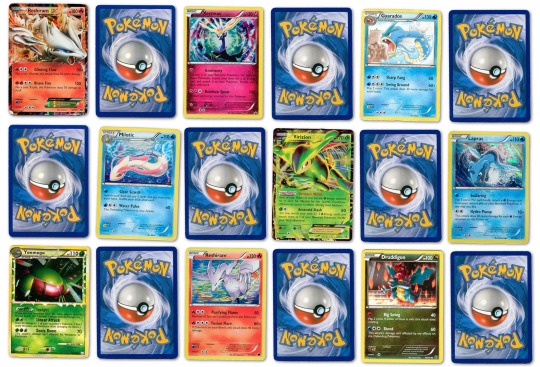
Inspired by the video game, Pokémon cards are used both as collectors items and as game playing cards. Some rare cards are worth thousands of dollars. Photograph By Oreolife/Alamy Stock Photo
Pokémon 1990s-Present
Trading cards morphed into gameplay by the close of the 20th century. In 1993, while working on his PhD in mathematics at the University of Pennsylvania, Richard Garfield invented Magic: The Gathering, which is one of the most well-known trading games today.
Around the same time, a game designer and an illustrator in Japan pitched Nintendo on a game called Pocket Monsters. In 1996, Pocket Monsters—which would later be renamed Pokémon—was released as a video game and went on to sell millions of copies.
Months later, a companion trading card game was produced, which contained 102 illustrated cards. One year after the U.S. release of Pokémon in 1998, the Pokémon Trading Card Game was introduced to North America by the same company that created Magic: The Gathering. More than 30 billion Pokémon cards have been printed today.
#History | Trading Cards#Original Pokémon#T’ang Dynasty#Elaina Zachos#National Geographic#The Walt Disney Company#Egypt 🇪🇬 | Italy 🇮🇹 | Spain 🇪🇸 | France 🇫🇷 | China | US 🇺🇸
1 note
·
View note
Text
Black Tea – History, Benefits, Recipes, and More

For centuries, black tea has been cherished for its robust flavor and numerous health benefits. This article delves into the rich history of black tea, its goodness, properties, and various recipes that can be prepared with it. We will also explore the advantages and disadvantages of consuming black tea, its effects on skin, and its nutritional value. black tea properties
The History of Black Tea
Black tea, scientifically known as Camellia sinensis, has a long and fascinating history that dates back to ancient China. According to legend, black tea was discovered accidentally when tea leaves were left out to oxidize, resulting in a darker and more flavorful brew. It was initially known as "dark tea" due to its color, and it gradually gained popularity beyond China's borders.
During the Tang dynasty (618-907 AD), black tea started to be appreciated for its unique qualities. By the time of the Ming dynasty (1368-1644 AD), black tea became a significant export, and its popularity spread to Europe via the Silk Road and maritime trade routes. It was during the 17th century that black tea gained popularity in Britain, and it soon became an integral part of British culture, giving rise to traditions like afternoon tea.
Black Tea Benefits and Properties
Black tea is renowned for its numerous benefits and unique properties. Let's delve into some of them:
1. Goodness of Black Tea: Black tea is rich in antioxidants, particularly polyphenols like catechins and theaflavins, which have potent health-boosting properties. These antioxidants help combat free radicals in the body, reducing oxidative stress and promoting overall well-being.
2. Black Tea with Lemon Benefits: Combining black tea with lemon enhances its benefits. Lemon is a rich source of vitamin C, which can boost the absorption of tea's antioxidants. The combination is believed to aid in weight loss, improve digestion, and provide a refreshing flavor.
3. Health Benefits of Black Tea: Regular consumption of black tea has been associated with several health benefits, including improved heart health, reduced risk of stroke, and lower cholesterol levels. The presence of flavonoids in black tea may help relax blood vessels and lower blood pressure. dark tea benefits
4. Nutritional Value of Black Tea: Black tea is a low-calorie beverage that provides essential nutrients like potassium, manganese, and various vitamins, including B-complex vitamins. It also contains caffeine, which can help improve alertness and concentration.
5. Benefits of Drinking Black Tea without Sugar: One of the significant advantages of black tea is that it can be enjoyed without the addition of sugar or sweeteners. This makes it a healthier alternative to sugar-laden drinks, promoting weight management and reducing the risk of dental issues.nutrients in black tea
6. Benefits of Black Tea with Ginger: Adding ginger to black tea not only enhances its flavor but also offers additional health benefits. Ginger is known for its anti-inflammatory and digestive properties, and when combined with black tea, it can provide relief from nausea and improve digestion.
7. Black Tea Effects on Skin: Black tea benefits extend to skincare. The antioxidants in black tea can help fight signs of aging, reduce the appearance of wrinkles, and promote healthy skin. Applying cooled black tea bags to the skin can soothe sunburns and reduce puffiness around the eyes.
8. Health Properties of Black Tea: Beyond antioxidants, black tea contains compounds like theaflavins and thearubigins, which are linked to cancer prevention and immune system support. These properties make black tea a valuable addition to a balanced diet.
How to Prepare Black Tea for Weight Loss
Many individuals turn to black tea as a part of their weight loss journey due to its various benefits. Here's a simple method to prepare black tea for weight loss:
Ingredients:
1 black tea bag or 1 teaspoon of loose black tea leaves
1 cup of hot water
Lemon slices (optional)
Instructions:
Boil a cup of water and let it cool slightly.
Place the black tea bag or tea leaves in a teacup.
Pour the hot water over the tea bag or leaves.
Allow it to steep for 3-5 minutes, or until you achieve your desired strength.
Remove the tea bag or strain the leaves.
Optionally, add lemon slices for extra flavor and benefits.
Enjoy your black tea without any sugar or sweeteners.
Black Tea Disadvantages and Side Effects
While black tea offers numerous advantages, it's essential to be aware of potential disadvantages and side effects:
1. Caffeine Content: Black tea contains caffeine, which can lead to insomnia, anxiety, and digestive issues if consumed in excess. It's advisable to moderate your intake, especially if you are sensitive to caffeine. black tea side effects
2. Staining: The dark color of black tea can stain teeth. Regular dental hygiene practices can help mitigate this issue. black tea benefits for skin
3. Iron Absorption: Some studies suggest that the tannins in black tea may inhibit the absorption of non-heme iron from plant-based foods. If you have an iron deficiency, consider consuming tea between meals.
4. Gastrointestinal Discomfort: Excessive consumption of black tea can lead to digestive discomfort, including acidity and stomach upset. It's crucial to consume it in moderation.
In conclusion, black tea is a versatile beverage with a long and storied history. Its benefits, including antioxidants, nutritional value, and potential for weight loss, make it a popular choice among tea enthusiasts. When consumed mindfully and in moderation, black tea can be a delightful and healthful addition to your daily routine, offering both taste and wellness benefits. So, brew yourself a cup of black tea, savor its rich flavor, and relish the goodness it brings to your life.
0 notes
Text
All About Black Oranda Goldfish & 4 Facts
Learn about the fascinating world of the Black Oranda Goldfish. Discover their appearance, behavior, lifespan, care requirements, breeding techniques, and how they differ from other Oranda Goldfish varieties. Determine why your Black Oranda Goldfish is turning gold or orange.
Investigate the possibility of keeping Black Oranda Goldfish as pets and their role in aquascaping. Learn about their history, color options, and pricing considerations.
Introduction
The Black Oranda Goldfish is a distinct and popular goldfish variety known for its striking appearance and intriguing features. We will delve into the characteristics, care requirements, breeding considerations, and additional information about Black Oranda Goldfish in this explanation.
What exactly is a Black Oranda Goldfish?
The Black Oranda Goldfish is a goldfish variety known for its distinct features. The body is rounded, with a double tail and a prominent wen, which is a fleshy growth on the head that covers the gills and extends over the eyes. The Black Oranda Goldfish has a striking appearance due to its deep black coloration throughout its body, fins, and wen. Its distinct appearance and graceful swimming behavior make it a popular choice among goldfish enthusiasts.
The Origins of the Black Oranda Goldfish
The Black Oranda Goldfish is a popular goldfish variety with a distinct appearance. Its origins can be traced back to ancient China, where selective breeding for specific goldfish traits began around the Tang Dynasty (618-907 AD).
During the Ming Dynasty (1368-1644 AD), the Oranda Goldfish was developed. It is thought to have evolved from a crossbreeding of the Veiltail Goldfish and the Lionhead Goldfish. As a result, a fish with a rounded body and a prominent headgrowth known as a wen was created.
The Black Oranda Goldfish emerged as a color variant of the Oranda breed. Breeders aimed to develop goldfish with a deep black coloration throughout their bodies, including the wen, through selective breeding. This method entailed selecting individuals with the darkest pigmentation and then breeding them to improve the black coloration in future generations.
Black Oranda Goldfish became popular not only in China, but all over the world. With its round body, wen, and striking black coloration, the fish was highly sought after by goldfish enthusiasts and collectors.
Black Oranda Goldfish can now be found in ornamental ponds and aquariums. They require proper care and maintenance, such as regular water changes, a balanced diet, and enough swimming space. Their graceful beauty continues to captivate hobbyists, making them a popular variety in the world of goldfish keeping.
Overview of the Black Oranda Goldfish
The Black Oranda Goldfish is a type of goldfish with unique characteristics. It has a rounded body shape and a prominent hood or wen on its head that grows as the fish grows older. The Black Oranda is mostly black, but it can have metallic scales that reflect light and give it a subtle shimmer. This goldfish is highly valued by hobbyists due to its distinct appearance and graceful swimming style. To thrive, it needs a large aquarium with clean water, proper filtration, and a well-balanced diet. Water parameters must be monitored and maintained on a regular basis to ensure their health.
Characteristics
Black Oranda goldfish are a type of fancy goldfish that are distinguished by their physical characteristics. Here are some key points to remember about them:
Black Orandas have a round, chubby body shape with a distinctive wen (head growth) that extends backward over their head and covers the area between their eyes. They are distinguished from other goldfish varieties by their jet-black or deep black coloration.
Wen Development: The wen on a Black Oranda grows with the fish, often covering its entire face and giving it a distinct and striking appearance. The wen can take several years to fully develop.
Proper care is required for Black Oranda goldfish. They require a large aquarium with at least 20 gallons of water per fish. Good filtration, regular water changes, and a well-balanced diet are essential for their health. Avoid using sharp decorations that could harm their wen.
Water conditions: Black Orandas prefer a pH of 6.5 to 7.5 and a temperature range of 65-75°F (18-24°C). It is critical for their overall health to have clean, well-oxygenated water.
Feeding: Because these goldfish are omnivorous, they require a varied diet. Provide them with high-quality pellets or flakes designed specifically for goldfish, supplemented with small portions of frozen or live foods like brine shrimp, daphnia, or bloodworms. Be careful not to overeat, as this can lead to health problems.
Compatibility: Black Oranda goldfish are generally calm and social. They can be kept in a community tank with other fancy goldfish varieties. However, keep them away from nippy or aggressive fish that could nip at their long fins or delicate wen.
Breeding Black Orandas necessitates the careful selection of compatible mates. To begin breeding, give them a separate breeding tank with plenty of hiding spots and spawning mops. They are egg layers, and the eggs should be removed immediately to prevent the adults from eating them. Raising the fry necessitates special attention and care.
Remember that proper care and a suitable environment are critical for the well-being of Black Oranda goldfish. Regular monitoring and prompt action in the event of any health issues will help to ensure their longevity and vibrancy.
Appearance
Black Oranda goldfish are a type of goldfish with unique characteristics. They have a round body shape and a distinctive hood or "wen" on their head that grows as they grow older. The wen partially covers their face and varies in size and shape depending on the individual.
Black Orandas, as the name implies, have a black coloration throughout their bodies, including their fins and eyes. It is important to note, however, that the black coloration can vary in intensity, ranging from deep black to a lighter shade with gray hints. The black color's intensity may also change with age.
Black Orandas require a well-maintained aquarium or pond with plenty of swimming space. They prefer clean, oxygenated water in the 65-75°F (18-24°C) temperature range. It is critical to provide a balanced diet of high-quality pellets, flakes, vegetables, and occasional live or frozen foods for their overall health.
Breeding Black Oranda goldfish necessitates a separate breeding tank with suitable spawning medium, such as plants or spawning mops. Female Orandas lay adhesive eggs, which male goldfish fertilize through external fertilization. Following successful breeding, the eggs must be carefully monitored and protected until they hatch, which usually takes a few days.
To summarize, Black Oranda goldfish are distinguished by their round body shape and the presence of a hood or wen on their head. They are black all over, and their care entails providing a suitable aquatic environment as well as a balanced diet. Breeding them necessitates specific conditions and close monitoring of the eggs until they hatch.
Temperament and behavior
Individuals' actions, reactions, and overall personality traits are referred to as their behavior and temperament. The observable actions, responses, and mannerisms displayed by a person or animal are referred to as behavior. Communication style, body language, social interactions, and decision-making patterns are all examples.
Temperament, on the other hand, refers to an individual's innate or inherent characteristics that influence how he or she behaves and responds to various stimuli. It is frequently regarded as a stable aspect of a person's personality and can have an impact on their emotional, social, and cognitive functioning. Temperament characteristics can include introversion/extroversion, sensitivity, adaptability, persistence, and mood stability.
Behavior and temperament are influenced by a combination of genetic and environmental factors. They can have an impact on how people interact with others, perceive situations, deal with stress, and approach tasks or challenges. Understanding behavior and temperament is useful in fields such as psychology, education, parenting, and animal training because it aids in predicting and managing responses as well as developing effective engagement and growth strategies.
Various Colors
Black Oranda goldfish are goldfish that have a striking black coloration. Their round body shape and prominent head growth, known as a wen or hood, distinguish them. The wen covers the entire head, including the gills and eyes, giving the fish a distinct appearance.
When it comes to care, Black Oranda goldfish require a clean aquarium with plenty of swimming space. To keep the water clean and oxygenated, proper filtration and regular water changes are required. These goldfish are omnivorous and should be fed a well-balanced diet of high-quality pellets, flakes, vegetables, and live or frozen foods on occasion.
Breeding Black Oranda goldfish can be a difficult task. It frequently entails selecting healthy and compatible breeding pairs, providing optimal conditions for them, and closely monitoring the spawning process. The eggs must be carefully cared for in a separate breeding tank until they hatch, and the fry (baby fish) must be fed appropriately and grow in a controlled environment.
In conclusion, due to their black coloration and unique head growth, Black Oranda goldfish are visually stunning. Proper care, including an appropriate aquarium setup and a balanced diet, is critical for their health. Breeding these goldfish necessitates careful selection, attention to detail, and nurturing the fry in order for them to reproduce successfully.
Lifespan of a Black Oranda Goldfish
A Black Oranda goldfish's lifespan varies, but on average, they live for 10 to 15 years. Proper care, such as a suitable environment, a balanced diet, and regular water quality maintenance, can all contribute to their longevity. The lifespan of these fish is also determined by factors such as genetics, overall health, and living conditions.
How many different kinds of Black Oranda Goldfish are there?
The classic Black Oranda and the Red Cap Black Oranda are the two main types of Black Oranda Goldfish.
Maintenance and Care
How to Look After a Black Oranda Goldfish
Black Oranda Goldfish, also known as Veiltail Orandas, are a beautiful species of goldfish with a distinctive black coloration and a prominent head growth known as a "wen." They require proper care to thrive in captivity, so if you want to keep Black Oranda Goldfish, here are the steps to take:
Tank Size: The first step in caring for your Black Oranda Goldfish is to provide them with a suitable tank. As a general rule, you should have at least 20 gallons of water per fish. Black Oranda Goldfish can grow to be up to 8 inches long, so make sure they have enough room to swim around and stay healthy.
Water Quality: It is critical to maintain good water quality for the health of your Black Oranda Goldfish. You should test the water for ammonia, nitrite, and nitrate levels on a regular basis to ensure they remain safe. The pH level should be between 7.0 and 7.4, and the temperature should be between 65 and 72 degrees Fahrenheit.
Filtration: Proper filtration is essential for keeping your Black Oranda Goldfish's water clean and healthy. It is recommended that you use a filter that can handle 5-10 times the volume of your tank. Additionally, depending on the size of your tank, you should perform regular water changes once a week or every two weeks.
Diet: Black Oranda Goldfish are omnivores, which means they consume both plant and animal matter. You should feed them high-quality commercial pellets or flakes supplemented with fresh vegetables such as peas, lettuce, and spinach. It is critical not to overfeed your fish and to only feed them what they can consume in a few minutes.
Tank Decorations: Providing proper tank decorations for your Black Oranda Goldfish is not only aesthetically pleasing but also important for their health. Plants, rocks, and ornaments should be added to provide them with hiding places and to create a natural environment. However, make sure the decorations are smooth and have no sharp edges that could harm your fish.
Tank Mates: Black Oranda Goldfish are peaceful and can be kept with other peaceful fish species with similar water needs. They should not, however, be kept with aggressive or fin-nipping fish, as this can stress and injure your Black Oranda Goldfish.
Observation: It is critical to keep an eye on your Black Oranda Goldfish on a regular basis to ensure they are healthy and thriving. Examine the patient for any signs of illness, such as lethargy, loss of appetite, or unusual behavior, and take appropriate action if necessary.
Finally, providing a suitable tank size, maintaining good water quality, providing a healthy diet, providing appropriate tank decorations, selecting appropriate tank mates, and regularly observing their behavior to ensure they are happy and healthy are all part of caring for Black Oranda Goldfish. You can enjoy the beauty of these fascinating fish in your aquarium for many years to come if you follow these steps.
Distribution and Habitat
The natural environment or specific ecological conditions in which a particular organism or species lives are referred to as its habitat. Climate, topography, vegetation, and available resources are all factors. The geographic range or area where a species is found, on the other hand, is referred to as its distribution.
To summarize:
The natural environment or ecological conditions in which an organism lives are referred to as its habitat.
Geographic range or area where a species can be found.
Tank Setup and Conditions
The specific requirements and environment required to create a suitable habitat for keeping fish or other aquatic organisms in an aquarium are referred to as tank conditions and setup.
Important considerations for tank conditions and setup include:
Tank size: Select a suitable tank size based on the type and number of fish you intend to keep. Make sure there is enough swimming space and that proper filtration and maintenance is possible.
Water quality: Keep water parameters like temperature, pH, ammonia, nitrite, and nitrate levels at optimal levels. To ensure a healthy environment, test the water on a regular basis and perform any necessary water changes or treatments.
Filtration system: Install a dependable filtration system that removes debris and waste mechanically and biologically while providing adequate oxygenation. Consider tank size, fish load, and the type of filtration (e.g., sponge, hang-on-back, canister) that will work best for your setup.
Heating and lighting: Set the temperature and lighting levels for the species in your tank. Use a heater with a thermostat to keep the temperature stable, and if desired, choose lights that promote natural day-night cycles and plant growth.
Substrate and decorations: To create a natural and aesthetically pleasing environment, choose a suitable substrate (gravel, sand, etc.) and incorporate decorations (rocks, driftwood, plants). When choosing these elements, keep your chosen species' preferences and compatibility in mind.
Aquascaping entails arranging the tank layout to provide hiding spots, territories, and enough swimming space for the fish. Take into account the natural behavior and requirements of the species you intend to keep.
Research and select fish that are compatible in terms of temperament, size, and water requirements. Avoid overcrowding and make sure each fish has enough space to thrive.
Feeding and care: Provide a balanced diet appropriate for the species you keep. Clean the tank on a regular basis, monitor water parameters, and perform necessary maintenance tasks such as filter cleaning, algae removal, and gravel vacuuming.
Remember that different species have different needs, so it's critical to research and comprehend the specific needs of the fish or aquatic organisms you intend to keep. Regular observation and adjustments to tank conditions will help ensure your aquatic pets' health and well-being.
Keeping Water Quality
Water quality maintenance entails ensuring that the water supply remains clean, safe, and suitable for its intended use. This is accomplished through a variety of means, including:
Implementing measures to protect water sources such as rivers, lakes, and groundwater from pollution, contamination, and depletion is known as source protection.
Water treatment is the process of removing impurities, pathogens, and pollutants from water by using processes such as filtration, disinfection (e.g., chlorination), and sedimentation.
Testing on a regular basis to monitor parameters like pH, turbidity, dissolved oxygen, bacteria levels, and the presence of chemicals or heavy metals.
Maintaining well-designed and properly functioning infrastructure for water storage, distribution, and sewage systems to prevent leaks, cross-contamination, and pollutant introduction.
Environmental management is the practice of implementing practices that reduce the release of pollutants into bodies of water, such as controlling industrial discharges, managing agricultural runoff, and promoting responsible waste disposal.
Regulatory Compliance: Enforcing and adhering to water quality regulations and standards established by local authorities or governing bodies in order to ensure consistent water quality monitoring, reporting, and improvement.
Public Education: Raising public awareness of the importance of water conservation, pollution prevention, and responsible water use in order to encourage individual and community efforts to maintain water quality.
We can help preserve and safeguard water quality by implementing these strategies, protecting both human health and the environment.
Diet and Feeding
The Black Oranda Goldfish, also known as the Black Veil Tail Oranda, is a popular ornamental fish with unique features. Here's an explanation of their feeding and diet, as well as care, breeding, and other details:
Feeding and Nutrition: Black Oranda Goldfish are omnivorous and require a well-balanced diet to thrive. Their diet should include a variety of foods, including high-quality flakes or pellets designed specifically for goldfish. Furthermore, adding fresh vegetables like spinach, peas, or lettuce to their diet can provide essential nutrients. To avoid obesity and digestive issues, it is critical to avoid overfeeding and monitor the amount of food they consume.
Keep in mind that this is only a general guide. Consultation with an experienced aquarist or veterinarian will provide you with more specific advice tailored to your specific situation.
Common Illnesses
Common fish diseases, including black Oranda goldfish, include:
Ich (Ichthyophthirius multifiliis): This disease, also known as white spot disease, causes white spots on the body and fins of fish. A parasite is to blame.
Fin Rot: This bacterial infection causes the fish's fins to degrade, making them appear frayed or disintegrating.
Dropsy is a symptom of an underlying problem rather than a disease in and of itself. It causes the fish to appear bloated due to fluid retention.
Swim Bladder Disorder: This condition affects the swim bladder, making it difficult for the fish to maintain buoyancy and swim properly.
Velvet Disease (Oodinium): This parasitic infection appears on the fish's skin and gills as a fine, golden-yellow dusting or rusty appearance.
Characteristics, Care, and Breeding of Black Oranda Goldfish:
The Black Oranda goldfish is a decorative goldfish with a distinctive round body shape and a prominent hood or head growth on top of its head. It is black in color, as the name suggests. It has long, flowing fins and can grow to be 8 inches (20 cm) long.
Black Oranda goldfish need a large aquarium with good filtration and frequent water changes. They prefer temperatures ranging from 65 to 75 degrees Fahrenheit (18 to 24 degrees Celsius). They are omnivorous and should be fed a well-balanced diet of high-quality fish pellets, flakes, and live or frozen foods such as brine shrimp or bloodworms on a regular basis.
Breeding involves providing appropriate breeding conditions, such as a separate breeding tank with spawning mops or plants for the eggs to attach to. The male will chase and nudge the female to release eggs, which he will then fertilize. Adults should be removed after spawning to prevent them from eating the eggs. The eggs will hatch in a few days, and the fry will need to be fed specialized fry food.
Because of their unique physical characteristics, black Oranda goldfish are prone to certain health issues such as swim bladder disorder and eye problems. Regular observation of their behavior, maintenance of water quality, and an appropriate diet can all help them stay healthy. It is critical for their well-being to provide adequate space and to reduce stressors.
*Please keep in mind that this information is based on general knowledge about common fish diseases as well as specific care guidelines for black Oranda goldfish. Consult reputable fishkeeping resources or experienced aquarists for detailed instructions and advice.
Reproduction and breeding
The processes involved in the production of offspring in living organisms are referred to as breeding and reproduction. By combining genetic material from two individuals to create new individuals, these processes ensure the survival of a species.
In the case of animals, breeding entails sexual reproduction, in which a male and female mate. The male transfers sperm to the female, which fertilizes her eggs, resulting in embryo development. Courtship rituals, mating behaviors, and physical adaptations for successful reproduction are all unique to different species.
Plants, on the other hand, frequently reproduce through pollination, in which pollen grains are transferred from the male reproductive organs of a flower to the female reproductive organs. This process results in fertilization and the formation of seeds, which can then develop into new plants.
Humans commonly use breeding programs to selectively propagate desirable traits in animals and plants. Breeders strive to improve characteristics such as productivity, disease resistance, and aesthetic qualities through careful selection and controlled mating.
Reproduction is a basic biological process that ensures species survival and diversity. It is critical to the preservation of ecological balance and the survival of life on Earth.
The reproductive habits of the Black Oranda Goldfish
Courtship, spawning, and parental care are all part of the Black Oranda Goldfish's reproductive behaviors. Males chase females and display vibrant colors to attract their attention during courtship. After forming a pair, the male will nudge the female's abdomen to induce egg release. Spawning occurs when the female releases eggs and the male externally fertilizes them. Because the parents may eat some of the eggs after spawning, it's common to separate them to protect the remaining ones. The eggs hatch in a few days, and the fry initially rely on their yolk sacs. Goldfish have limited parental care, but some may guard the fry or provide minimal protection.
Factors that influence breeding success
Genetic fitness, environmental conditions, resource availability, predation, competition, and parental care are all factors that influence breeding success.
Breeding and hatching methods for Black Oranda Goldfish
The following techniques are used to breed and hatch Black Oranda Goldfish:
Choosing breeding pairs: Select healthy adult Black Oranda Goldfish with desirable characteristics such as prominent head growth (wen) and a deep black coloration.
Conditioning the breeders: Ensure that the selected male and female goldfish are in good health and condition them with a protein-rich diet. Separate the breeders and gradually cool them down to simulate seasonal changes and stimulate spawning behavior.
Setting up a breeding tank: Make a separate breeding tank with plenty of space, proper filtration, and hiding spots using plants or spawning mops to keep the eggs safe from the parents.
In order to induce spawning, raise the water temperature to around 70-75°F (21-24°C) and provide slight lighting fluctuations to simulate spring conditions, which can trigger the breeding instinct. Additionally, simulate the rainy season with partial water changes to encourage spawning.
Observe spawning behavior, such as the male chasing and nudging the female and the female releasing eggs while the male fertilizes them. Remove the parents from the breeding tank once spawning is complete to prevent them from eating the eggs.
In order to ensure oxygenation, transfer the fertilized eggs to a separate incubation tank with gentle water flow. To prevent fungal infections, keep the water temperature between 72-78°F (22-26°C) and add fungicide. Depending on the temperature, the eggs will hatch in 4-7 days.
Caring for the fry: After hatching, the fry will survive on their yolk sacs. Introduce infusoria or commercially available liquid fry food to their diet after a few days. Transition them to finely crushed flakes or powdered fry food as they grow.
To ensure the health and survival of the fry, keep in mind that breeding goldfish necessitates careful monitoring of water parameters, regular maintenance, and proper nutrition.
Pet Black Oranda Goldfish?
Black Oranda Goldfish make excellent pets for fish lovers. They are a type of goldfish distinguished by their round body and a prominent head growth known as a wen. The black coloration adds a touch of elegance to their overall appearance.
Here are some important facts about keeping Black Oranda Goldfish as pets:
Hardiness: Oranda Goldfish, including the black variety, are hardy and adaptable in general. They can withstand a wide range of water conditions, making them ideal for both novice and experienced fish keepers.
Size and Lifespan: Depending on their environment and care, Oranda Goldfish can grow to be 8-12 inches (20-30 cm) long. They can live for more than ten years with proper care, and some have been known to live for fifteen years or longer.
Tank Requirements: Because of their size and swimming habits, these goldfish require large tanks. It is recommended that a minimum tank size of 20-30 gallons per fish be used, with larger tanks preferred. Adequate filtration and regular water changes are required to keep water quality high.
Oranda Goldfish are omnivorous and prefer a varied diet. They consume commercial fish flakes or pellets as well as fresh vegetables such as peas, lettuce, and spinach. It is critical to provide a well-balanced diet to support their health and prevent digestive issues.
Oranda Goldfish are generally peaceful and get along well with other goldfish breeds. However, it is critical to keep their size in mind and avoid housing them with fish that are small enough to eat or that may nip at their fancy tail fins.
Considerations for Care: To ensure a healthy environment, water parameters such as temperature, pH, ammonia, and nitrate levels must be monitored on a regular basis. Providing enough hiding places and gentle water flow will help protect their delicate wen.
Remember that maintaining good water quality, providing a proper diet, and providing adequate tank space are all important for the overall health of Black Oranda Goldfish. They can be delightful and fascinating pets to enjoy and admire if properly cared for.
Aquascaping with Black Oranda Goldfish
Because of their distinct appearance and behavior, Black Oranda Goldfish can be an intriguing addition to aquascaping. They can make an eye-catching focal point in the aquarium due to their distinct black coloration and flowing wen (head growth).
It is critical to consider the specific needs of Black Oranda Goldfish when incorporating them into aquascaping. Here are a few things to remember:
Tank size: Because black orandas can grow quite large, they require large tanks. To ensure adequate swimming space, a minimum tank size of 30 gallons per fish is recommended.
Water quality and filtration: Good filtration is essential for maintaining clean water conditions. Because goldfish generate a significant amount of waste, a strong filtration system is required to keep the water parameters stable.
Substrate and decoration: Use a goldfish-safe and easy-to-clean substrate, such as smooth gravel or sand. Avoid materials with sharp or rough edges that could injure their delicate fins. Choose decorations such as rocks, driftwood, and plants that will not harm the goldfish or impede their movement.
Plants: Although goldfish are known to nibble on plants, some species can coexist with them. Anubias, Java Fern, and Vallisneria are hardy and fast-growing plants that can withstand occasional nibbling and add some natural elements to the aquascape.
Feeding: Feed your Black Oranda Goldfish a balanced diet that includes a variety of high-quality pellets, flakes, and fresh vegetables. Overfeeding should be avoided because it can result in health problems and poor water quality.
Consider the compatibility of the Black Oranda Goldfish with other tankmates. They are generally peaceful, but they have been known to eat small invertebrates and nip at long-finned fish. Keep them away from aggressive or fin-nipping species.
To ensure the well-being of your Black Oranda Goldfish in the aquascape, remember to monitor water parameters on a regular basis, perform partial water changes, and provide proper care.
Other Oranda Goldfish Varieties vs. Black Oranda Goldfish
Black Oranda Goldfish is a type of Oranda Goldfish that is black in color. It is distinguished from other Oranda Goldfish species primarily by its color. Oranda Goldfish have a prominent head growth (wen) and a rounded body shape in general. Other Oranda Goldfish varieties, such as red, calico, or orange, may have different color patterns. The Black Oranda, on the other hand, stands out due to its distinctive black coloration, making it a one-of-a-kind and sought-after choice for fish enthusiasts.
Price of Black Oranda Goldfish?
A Black Oranda goldfish's price can vary depending on factors such as size, quality, and where it is purchased. Black Oranda goldfish prices can range from $10 to $50 on average, but some high-quality specimens or rare variations may cost more. For specific pricing information, it's always best to check with local pet stores or online fish retailers.
Goldfish vs. Black Oranda Goldfish?
Both Black Oranda Goldfish and Goldfish are popular aquarium fish, but they differ in some ways.
Black Oranda Goldfish are a type of fancy goldfish with a distinctive round body shape and a prominent hood on their head. They are usually black or dark metallic in color. Goldfish, on the other hand, refers to the most common types of goldfish, which come in a variety of colors such as orange, red, white, and calico patterns. They typically have a slim body shape.
One of the most distinguishing characteristics of the Black Oranda Goldfish is the growth on its head, known as the "hood" or "wen." This fleshy outgrowth covers the head region and develops as the fish matures. Regular Goldfish, on the other hand, do not have such head growth.
Care Requirements: In terms of water quality, temperature, and feeding, both Black Oranda Goldfish and Goldfish require similar care. However, due to their large heads, Black Oranda Goldfish may be more prone to health problems such as impaired vision or difficulty finding food, necessitating extra care from the owner.
Goldfish are widely available and can be purchased from most pet stores or breeders. Because Black Oranda Goldfish are a specific variety, they may be less common and require more effort or resources to find.
Popularity: Due to their appealing appearance and ease of care, goldfish are among the most popular aquarium fish worldwide. Black Oranda Goldfish are also highly sought after by hobbyists who appreciate their distinctive coloration and head growth.
In summary, while Goldfish refers to the various colors of goldfish, Black Oranda Goldfish is a specific variety with a round body shape, black or dark metallic coloration, and prominent head growth. Both have their own appeal and care needs, but the Black Oranda Goldfish stands out due to its distinct appearance.
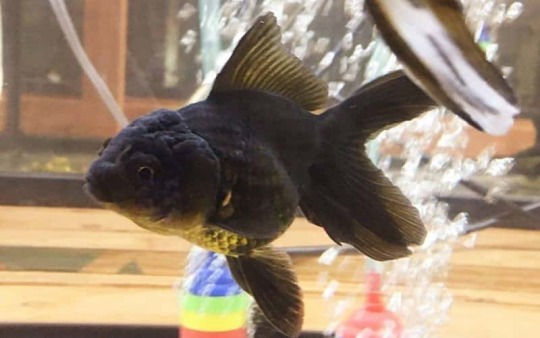
What is causing my Black Oranda Goldfish to turn gold?
Color changes in goldfish can be caused by a variety of factors such as genetics, diet, and environmental conditions. Your Black Oranda Goldfish turning gold is most likely a natural phenomenon known as "color fading" or "color change."
Oranda Goldfish are known for their vibrant colors and distinctive hoods or wen on their heads. The intensity of their color, however, can fade over time due to genetic factors or exposure to certain conditions. It's not uncommon for black-colored goldfish to mature and gradually turn golden or orange.
Changes in diet can also affect the overall coloration of goldfish. Nutritional deficiencies or imbalances in the diet can affect pigmentation, causing it to appear lighter or different in color.
Fish coloration is also affected by water quality and environmental conditions. High ammonia or nitrate levels, for example, can stress the fish and cause color changes. Maintaining optimal fish health and vibrant coloration requires a clean and healthy aquatic environment with appropriate filtration and regular water changes.
In conclusion, your Black Oranda Goldfish's black-to-gold color change is most likely a natural occurrence influenced by genetics, diet, and environmental factors. Regular water quality monitoring, a balanced diet, and a suitable environment will all help to ensure your goldfish's overall well-being and coloration.
What Causes Black Oranda Goldfish to Turn Orange?
The black pigment cells in their skin, known as melanophores, reduce their production of melanin, which is responsible for the black coloration, causing the black Oranda goldfish to turn orange. The underlying orange or red pigments become more visible as a result, giving the fish an orange appearance. Color fading can be caused by a variety of factors such as genetics, environmental conditions, and diet.
0 notes